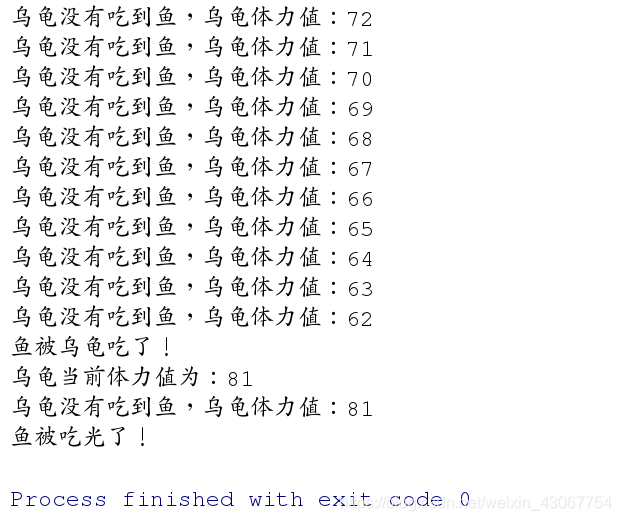#pygame 可以设置图形,这里不做讲解。
游戏编程:按以下要求定义一个乌龟类和鱼类并尝试编写游戏
假设游戏场景为范围(x,y)为0<=x<=10,0<=y<=10
游戏生成1只乌龟和10条鱼
它们的移动方向均随机
乌龟的最大移动能力为2(它可以随机选择1还是2移动),鱼儿的最大移动能力是1
当移动到场景边缘,自动向反方向移动
乌龟初始化体力为100(上限)
乌龟每移动一次,体力消耗1
当乌龟和鱼坐标重叠,乌龟吃掉鱼,乌龟体力增加20
鱼暂不计算体力
当乌龟体力值为0(挂掉)或者鱼儿的数量为0游戏结束
import random
class Turtle(object):
# 构造函数什么时候执行? =---=====创建对象时执行
def __init__(self): # self指的是实例化的对象;
# 乌龟的属性: x,y轴坐标和体力值
# 乌龟的x轴, 范围1,10
self.x = random.randint(1, 10)
self.y = random.randint(1, 10)
# 乌龟初始化体力为100
self.power = 100
# 类的方法:
def move(self):
# 乌龟的最大移动能力为2,规定为:[-2, -1, 0, 1, 2]
move_skill = [-2, -1, 0, 1, 2]
# 计算出乌龟的新坐标(10, 12)
new_x = self.x + random.choice(move_skill)
new_y = self.y + random.choice(move_skill)
# 对于新坐标进行检验, 是哦否合法, 如果不合法, 进行处理
self.x = self.is_vaild(new_x)
self.y = self.is_vaild(new_y)
# 乌龟每移动一次,体力消耗1
self.power -= 1
def is_vaild(self, value):
"""
判断传进来的x轴坐标或者y轴坐标是否合法?
1). 如果合法, 直接返回传进来的值;
2). value<=0; =====> abs(value);
3). value > 10 ======> 10-(value-10);
:param value:
:return:
"""
if 1 <= value <= 10:
return value
elif value < 1:
return abs(value)
else:
return 10 - (value - 10)
def eat(self):
"""
当乌龟和鱼坐标重叠,乌龟吃掉鱼,乌龟体力增加20
:return:
"""
self.power += 20
class Fish(object):
# 构造函数什么时候执行? =---=====创建对象时执行
def __init__(self):
# 鱼的属性: x, y轴坐标
# 鱼的x轴, 范围1,10
self.x = random.randint(1, 10)
self.y = random.randint(1, 10)
# 类的方法:
def move(self):
# 鱼的最大移动能力为1,[ -1, 0, 1]
move_skill = [-1, 0, 1]
# 计算出鱼的新坐标(10, 12)
new_x = self.x + random.choice(move_skill)
new_y = self.y + random.choice(move_skill)
# 对于新坐标进行检验, 是否合法, 如果不合法, 进行处理
self.x = self.is_vaild(new_x)
self.y = self.is_vaild(new_y)
def is_vaild(self, value):
"""
判断传进来的x轴坐标或者y轴坐标是否合法?
1). 如果合法, 直接返回传进来的值;
2). value<=0; =====> abs(value);
3). value > 10 ======> 10-(value-10);
:param value:
:return:
"""
if 1 <= value <= 10:
return value
elif value < 1:
return abs(value)
else:
return 10 - (value - 10)
def main():
# 创建一个乌龟;
turtle = Turtle()
print(turtle.x, turtle.y)
# for循环创建10个鱼
# fishs = []
# for i in range(10):
# fishs.append(Fish())
# 创建10个鱼对象;
fishs = [Fish() for i in range(10)]
# 游戏开始
while True:
# 判断游戏是否结束?( 当乌龟体力值为0(挂掉)或者鱼儿的数量为0游戏结束)
if turtle.power <= 0:
print("乌龟没有体力了, Game over......")
break
elif len(fishs) == 0:
print("鱼被吃光, Game over......")
break
else:
# 游戏没有结束. 乌龟和鱼随机移动
turtle.move()
# 鱼移动
for fish in fishs:
fish.move()
# 判断鱼是否被乌龟吃掉?
# 当乌龟和鱼坐标重叠,乌龟吃掉鱼,乌龟体力增加20
if turtle.x == fish.x and turtle.y == fish.y:
turtle.eat()
# 删除被乌龟吃掉的鱼
fishs.remove(fish)
print("鱼被乌龟吃掉, 还剩%d条鱼....." % (len(fishs)))
print("乌龟的最新体力为%s" % (turtle.power))
# 乌龟跟10个鱼都比较结束后, 没有发现吃到一个鱼, 才执行, 跟for是一块的;
else:
print("乌龟没有吃到鱼,最新体力为%s" % (turtle.power))
# pygame
if __name__ == "__main__":
print("游戏开始".center(30, "*"))
main()
因为乌龟和鱼有很多相同的属性和方法,所以可以合并成一个Animal类。
import random
class Animal(object):
"""
将乌龟和鱼的共同特性抽象出来的类
"""
def __init__(self):
self.x = random.randint(1,10)
self.y = random.randint(1,10)
def move(self,move_skill):
new_x = self.x + random.choice(move_skill)
new_y = self.y + random.choice(move_skill)
self.x = self.is_vaild(new_x)
self.y = self.is_vaild(new_y)
def is_vaild(self,value):
if 1 <= value <= 10:
return value
elif value<1:
return abs(value)
elif value >10:
return 10-(value-10)
class Turtle(Animal):
def __init__(self):
super(Turtle,self).__init__()
self.power=100
def move(self,move_skill= (-2,-1,0,1,2)):
super(Turtle,self).move(move_skill)
self.power -= 1
def eat(self):
self.power += 20
class Fishs(Animal):
def move(self,move_skill=(-1,0,1)):
super(Fishs,self).move(move_skill)
def main():
turtle = Turtle()
fishs = [Fishs() for i in range(10)]
while True:
if turtle.power <= 0:
print('乌龟没有体力了')
break
elif len(fishs) == 0:
print('鱼被吃光了!')
break
else:
turtle.move()
for fish in fishs:
fish.move()
if turtle.x == fish.x and turtle.y == fish.y:
turtle.eat()
fishs.remove(fish)
print('鱼被乌龟吃了!')
print('乌龟当前体力值为:%d' %(turtle.power))
else:
print('乌龟没有吃到鱼,乌龟体力值:%d' %(turtle.power))
if __name__ == '__main__':
print('游戏开始!'.center(50,'*'))
main()

